
















Export Promotion Council and Brand Kenya Board merged to form
Kenya Export Promotion and Branding Agency
Kenya Export Promotion and Branding Agency is a state corporation that offers integrated solutions for all trade promotion and nation branding activities for Kenya, covering local, regional and international engagements.
To Transform Kenya into a Top Global Brand
OUR MISSION
Brand Kenya, Export Kenyan, Build Kenya
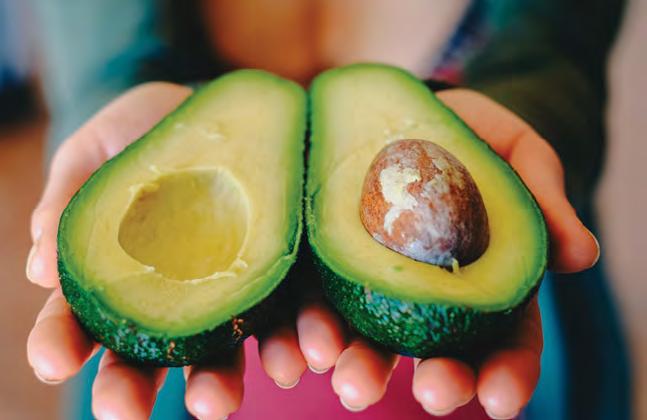


OUR SERVICES
Export Trade Information Services
Advocacy and Trade Policy Facilitation
Market Intelligence
International Market Development and Promotion
Enterprise and Product Development
Market Research & Surveys

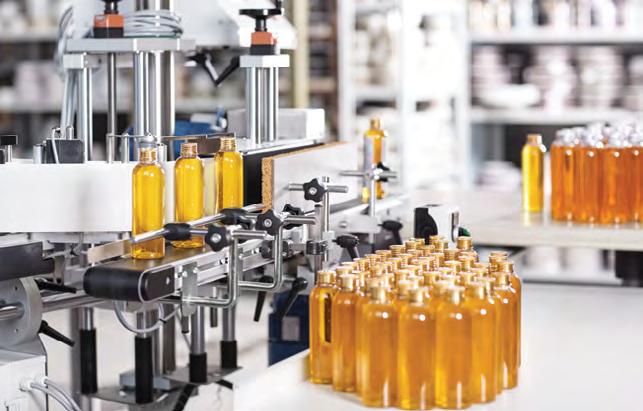
We always ask ourselves, “Does this meet the important needs of Kenyans and
We seek to create such a strong emotional connection with Kenyans and our export markets so that they rally behind us.
We seek to connect, engage, inspire and make meaningful connections with Kenyans and our exporters.
The Agency’s mandate is to implement export promotion and nation branding Initiatives and policies to promote Kenya’s export of goods and services. The Agency’s Core activities include: -
To facilitate adaptation and promote Kenya’s priority export products in prioritized export markets.
To enhance visibility of Kenya’s export products in regional and international markets.
To position Kenya as a top global brand.
To strengthen institutional capacity to deliver on KEPROBA’s mandate.


AREA
582650 sq Km
POPULATION
54M
OFFICIAL LANGUAGE
English

GDP (2020)
US$ 98.84B
FDI Inflows (2020)
US$ 717B
GDP Growth (2020) 0.3%
FDI Growth (2017) 34.7%


AGE STRUCTURE







0-14 years: 40.02%


15-35 years: 35%
36-64 years: 21.98%
65 years and over: 3%
POLITICAL SYSTEM
Devolved State with Multiparty Democracy, 47 counties. Kenya lies on the equator and enjoys a varied climate ranging from tropical to temperate (10° to 40°c).
Average GDP Per Capita(2020)
US$ 1,838
Average Exchange Rate
US$ 1 - KES 109.8


A step towards a continental free trade area
Libya
Egypt
Sudan
COMESA + SADC
D. R. Congo
Zambia
Malawi
Zimbabwe
Swaziland
Madagascar
Angola
Namibia
Botswana
Eritrea
Eritrea
Ethiopia
Countries 26
Population 625 Million
Total GDP $ 1 trillion
Aim
Djibouti
Djibouti
Boost Trade Between African countries
COMESA + EAC
Uganda
Kenya
Rwanda
Burundi
South Sudan
SADC + EAC
Tanzania
Mozambique
Lesotho South Africa
Seychelles
Comoros
EAC
East African Community
Tripartite Free Trade Area Links 3 regional blocs
SADC
South African Development Community
Intra-regional trade as a share of region’s total exports
Mauritius
Common Market of East and Southern Africa
Source: UNCTAD
 Joanne Wanjala
Joanne Wanjala
Welcome to our 5th issue of the MAKE IT KENYA Magazine where our focus is on the European Union (EU) region. This Publication takes an indepth look at Kenya’s exports and bilateral relations with the European Union with a keen focus on France, Germany, Netherlands and the United Kingdom.
The European Union (EU) is a supranational political and economic union of 27 member states that are located primarily in Europe according to Organisation for Economic Co-operation and Development. The union has a total area of 4,233,255.3 km2 and an estimated total population of about 447 million people which equates to approximately 5.8% of the world population. As of 2021, the European Union generated a nominal Gross Domestic Product (GDP) of about US $ 17.1 Trillion, an equivalent of 18 percent of the global nominal GDP.
The European Union is currently made up of 27 member States: Austria, Belgium, Bulgaria, Croatia, Republic of Cyprus, Czech Republic, Denmark, Estonia, Finland, France, Germany, Greece, Hungary, Ireland, Italy, Latvia, Lithuania, Luxembourg, Malta, Netherlands, Poland, Portugal, Romania, Slovakia, Slovenia, Spain and Sweden.
Kenya seeks to diversify her market within the region by focusing on value addition of products such as flowers, avocados, vegetables, tea, coffee and mangoes to reach a wider market hence increasing export trade.
To enhance the better understanding of trade relations within the region, the European Union issue will focus Kenya’s trade with the United Kingdom, France, Germany and Netherlands.
Enjoy the read and keep choosing Kenya.
Mr. Jaswinder Bedi, EBS, MBS - Chairman
Mr. Ambrose R.M. Ogango
Director - Alt. to PS, The National Treasury
Ms. Leah Aywah Baraza
Director - Alt. to the Attorney General
Mafaka Michael Ngugi Karanja
Independent Director
Mulki Warsame Mohamed
Independent Director
Dr. Grace Kinya Muriithi – Kireria
Independent Director
Floice Mukabana - Chief Executive Officer
EDITOR IN CHIEF: Maureen Mambo MPRSK
EDITORS: Joane Wanjala Jonah Karanja
DESIGN & LAYOUT: Samuel Njaaga
CONTRIBUTORS: Jonah Karanja


The relationship between Kenya and the European Union dates to 1976 when the European Delegation was opened in Nairobi. In the same year, Kenya became the first African country to sing a cooperation agreement with the European Community under the Lome Convention.
The European Union has since become a key consumer of Kenyan products. The Europe based regional economic community accounts for 21.1% of Kenya’s exports to the world, mainly importing agricultural products: tea, cut flowers, peas coffee and beans. Kenya exports over 70% of her flower total flower production to the European Union, hence leading to the creation of over 500, 000 direct and indirect jobs for Kenyans.
Kenya is East Africa’s commercial hub thanks to its skilled labour, vibrant business community and favourable location that gives it an edge when it comes to accessing the Sub-Saharan markets. European countries consider Kenya as an economic hub and have in recent years increased their investments in our nation. The investments contribute a lot to the growth of our economy through jobs and tax generation.
The Kenya Export Promotion and Branding Agency (KEPROBA) is keen on diversifying
export products to the EU through partnerships with the like of National Board Trade Sweden - Open Trade Gate Sweden. Recently, KEPROBA helped in the recruitment of 10 SMEs drawn from buts, herbs & spices and tea sectors for a market exploration mission in Sweden. The mission was a great opportunity for Kenyan companies to market their products and expand their consumer base to the European Union. During this period, the companies had the opportunity to meet potential buyers, showcase their products, and engage in B2B meetings to explore business opportunities in Europe.
The Economic Partnership Agreement (EPA) signed between Kenya and the European Union is expected to give Kenyan products duty-free access to the over 446-million-dollar European market. The interim agreement is expected to be a placeholder for the Economic Partnership Agreement (EPA) between the EU and the East African Community (EAC) countries, of which Kenya is a member. The implementation of the EPA agreement further underscores the for-significance trade ties between Kenya and the European Union trading bloc.
The European Union accounts for 15% of the worlds exports and imports and will therefore create market access for value added and raw products from Kenya hence improving our economy and the livelihoods of our people across Kenyan value chains.
“ Kenya’s partnership with the European Union bolsters our economy, providing duty-free access to a vast market, creating jobs, and expanding export opportunities for our agricultural products and SMEs
 Floice Mukabana CEO KENYA EXPORT PROMOTION AND BRANDING AGENCY
Floice Mukabana CEO KENYA EXPORT PROMOTION AND BRANDING AGENCY


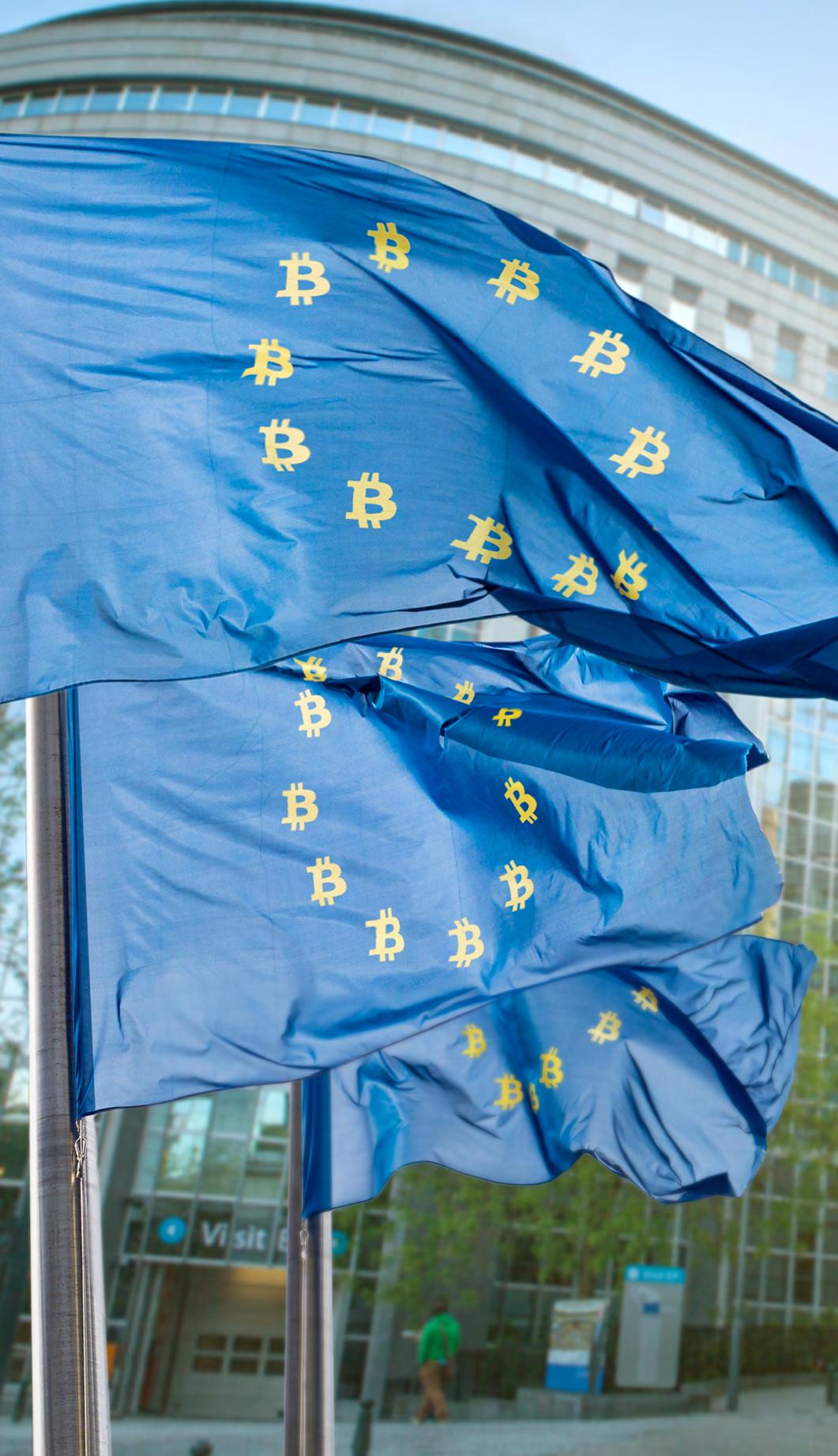
The European Union is a political and economic union of 27 member states in Europe that was established to promote peace, stability and economic prosperity among member states. The Union dates to the end of World War 2 with the formation of European Coal and Steel Community back in 1951. The current Union was established by the Maastricht Treaty in 1933. As the largest trading bloc in the world, the EU operates through a system of institutions that are used in decision making such as the European Council, The European Commission and the Court of Justice of the European Union.
The European Union has established a single market with free movement of people, goods, capital and services hence making it ideal for benchmarking to help in the implementation of the Africa Continental Free Trade Area. The union also engages in various policies that are geared towards fisheries, agriculture, environmental protection, consumer rights, foreign policy and regional development.
The EU’s role is crucial in shaping European policies and regulations, addressing common challenges such as climate change, security and migration, besides negotiating trade agreements with other countries. The Union has significantly impacted on the political, economic, and social landscape of Europe more than any other body.
Over 340 million people use the Euro currency for trade transactions in 20 countries. This eliminates the risk of currency fluctuations and inflation thus strengthening the single market. The EU has achieved a strong position by acting together with one voice on the global stage, rather than with separate trade strategies. When it comes to global trade, the EU is able to negotiate as a single entity hence making it the world’s leading global player accounting for 15% of the world’s total trade.
Kenya and the European Union (EU) have a vibrant and diverse commercial partnership that reflects their shared commitments and interests. The Economic alliance Agreement (EPA), the cornerstone of commercial cooperation between the European Union and African, Caribbean, and Pacific (ACP) nations, is at the center of this alliance. By giving Kenya privileged access to the sizable EU market, this agreement promotes trade in
products, services, and capital between the two organizations.
Kenya, which is well-known for its abundant agricultural output, exports a wide range of goods to the EU, including tea, coffee, fresh fruits and vegetables, flowers, and vegetables. Due to the EPA’s concessions, many commodities frequently enter the EU market duty-free or with lower tariffs. In exchange, Kenya imports a wide range of products and services from the EU, including technology, machinery, cars, and medications. The EPA makes it possible for some products to receive preferential treatment, which promotes fair trade relations even while some imports may face tariffs or other regulatory obstacles.
In addition to commerce, the EU and Kenya participate in larger cooperation projects that support investment, capacity building, and economic development. The EU funds programs to increase Kenya’s economic competitiveness and resilience as well as infrastructure projects and sustainable development initiatives. Furthermore, Kenya’s goals for progress and prosperity are strongly aligned with the EU’s commitment to advancing human rights, good governance, and sustainable development.
Nevertheless, there are still issues with the commercial relationship between Kenya and the EU. These issues range from non-tariff obstacles and regulatory gaps to external factors like volatile commodity prices and disputes in international commerce. Furthermore, new dynamics are brought about by Brexit, and trade plans and relationships must be revised and reevaluated. Despite these obstacles, Kenya and the EU acknowledge the enormous potential for future cooperation and benefits.
Future commercial relations between the EU and Kenya appear promising in terms of more cooperation, deeper integration, and sustainable development. Both sides are still dedicated to looking for new ways to collaborate and take advantage of new chances in fields including technology transfer, value-added manufacturing, and renewable energy. By means of sustained communication, collaboration, and common objectives, Kenya and the EU are well-positioned to enhance their trade ties, propelling economic expansion.
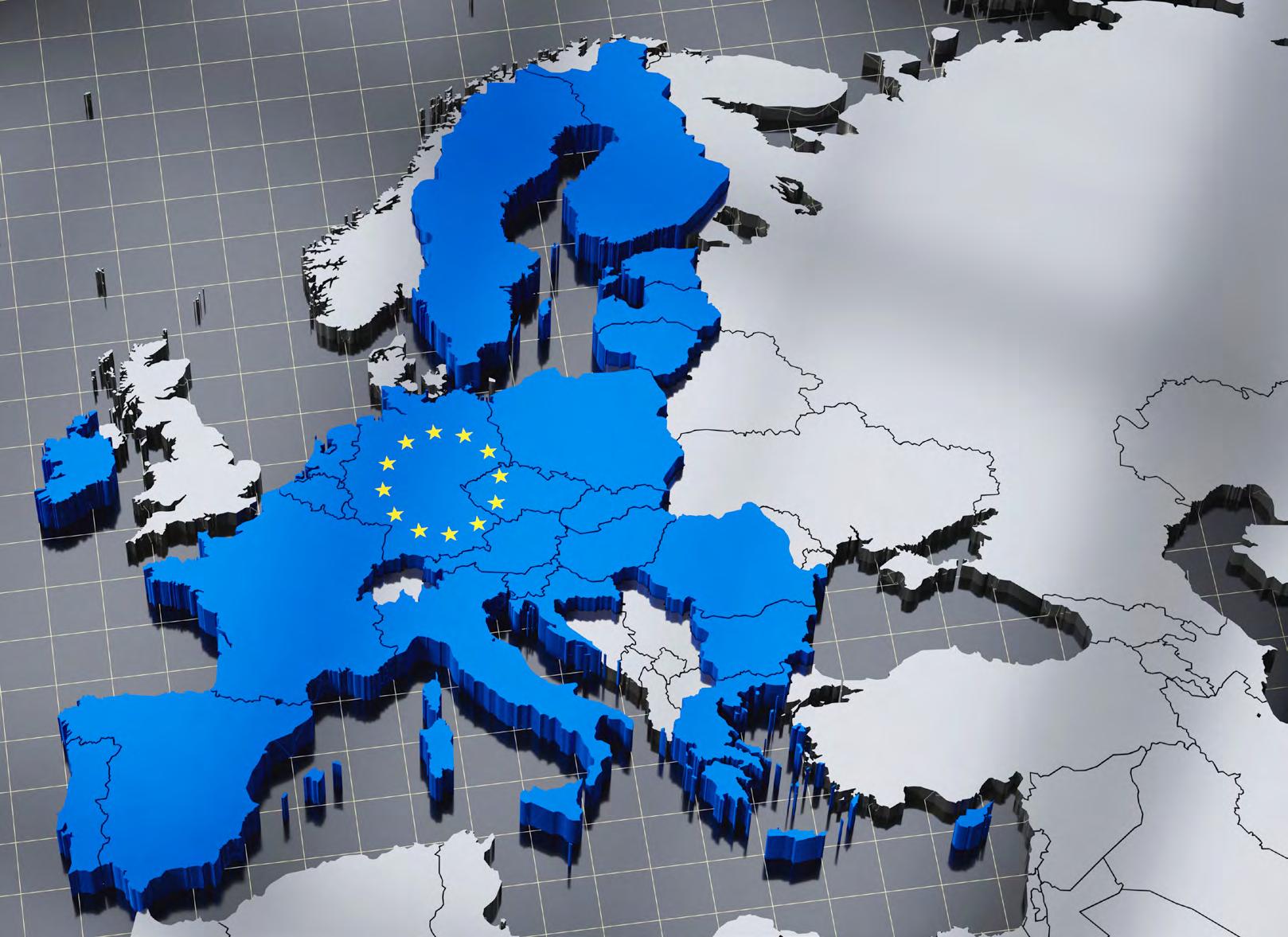



Kenya and the European Union (EU) have a complex relationship that involves several facets of social, political, and economic cooperation. Kenya has historical links with numerous EU members, having been a British colony in the past, which have developed into a comprehensive engagement with the EU.
Trade and economic collaboration are two of the main foundations supporting KenyaEU relations. With sizable trade flows in both directions, the EU is one of Kenya’s main commercial partners. Under several trade accords, including the Economic Partnership Agreement (EPA), which grants duty-free and quota-free access to the EU for the majority of Kenyan exports, Kenya is granted preferential access to the EU market. Kenya’s main exports to the EU include textiles, coffee, tea, and horticultural goods.
Conversely, Kenya receives EU exports of manufactured products, machinery, cars, and pharmaceuticals. Negotiations for a new trade agreement with the goal of strengthening economic connections have been continuous efforts to improve trade relations between Kenya and the EU.
Beyond commerce, Kenya and the EU work together on a number of development initiatives that support sustainable growth, sound governance, and the eradication of poverty in Kenya. Through grants and development aid programs centered on issues like infrastructure development, healthcare, education, and environmental conservation, the EU gives Kenya significant financial help. Furthermore, the EU backs programs that increase Kenya’s institutional strength and advance human rights, democratic governance, and the rule of law.
Kenya and the EU discuss and work together on global and regional problems of shared concern in the spheres of diplomacy and political cooperation. This include collaboration on managing migration, resolving conflicts,
addressing climate change, and maintaining peace and security. Kenya is a crucial ally for the EU in tackling regional issues and achieving common goals in Africa because of its advantageous location in the East African area.
Relationships between Kenya and the EU are influenced by cultural and interpersonal contacts, which promote cooperation and understanding between the two parties. Programs for educational and cultural exchange encourage student exchanges, academic collaboration, and cultural events that build bridges between Kenya and EU member states.
An all-encompassing collaboration encompassing trade, development cooperation, diplomacy, and cultural exchanges characterizes Kenya-EU relations overall. For the benefit of their respective populations as well as the larger region, both parties are still cooperating to strengthen and broaden their partnership, tackling shared issues and working toward mutual objectives as stated.
As the gateway to East, Central and Sub-Saharan Africa, Kenya’s peace and stability have a great impact in the EAC region. For this reason, Kenya and the European Union Kenya and the European Union have developed a consistent and long-term partnership over many years and share multilateral and global aims such as combating climate change and fostering peace and security.
Consisting of over 18 UN Agencies, Kenya is home to the home to United Nations in Africa. Among the UN Agencies in Kenya are the United Nations Environment Programme (UNEP) and the UN Human Settlement Programme (UN-HABITAT) both which advocate for environmental protection. Kenya and the European Union are collaborating on sustainable environment conservation besides addressing the negative impacts of climate.
The EU supports Kenya’s efforts in improving national and regional security. The European Union the EAC government in addressing violent extremism, counterterrorism and improving human rights. The EU under Common Security and Defence policy operates a number of missions in Kenya to:
a. Improve regional maritime security capacity including counter-piracy and maritime governance.
b. Prevent piracy and armed robbery off Somalia’s coast and protect World Food Programme and African Union Mission in Somalia (AMISOM) ships.
c. Strengthen the Somali Government’s security institutions with a deployed military training mission.
d. Reduce Chemical, Biological, Radiological and Nuclear risks (CBRN) as well as counterterrorism and organised crime.
The European Union represents Kenya’s biggest export market with 21.1%, of Kenya’s total exports to the world. The main exports to the world’s
biggest trading bloc are mainly agricultural produce such as tea, coffee, cut flowers, peas and beans. Kenya exports over 70% of her flowers to the European Union, creating over 500,000 direct and indirect jobs for Kenyans.
As the Commercial hub for the EAC region, Kenya has a favourable location, skilled labour force and a vibrant business community thus attracting top European companies that generate jobs and tax revenues.
Kenya is home to over 500,000 refugees from neighbouring countries. The European Union supports the refugees in Kenya and also the host communities in Garissa and Turkana counties. Kenya is prone to natural disasters due to unpredictable weather, climate change and locust invasion. To aid in EU humanitarian aid to Kenya has amounted to 200 million Euros since 2012 that is geared towards health care, nutrition, water, sanitation and hygiene food as well as protection and access to education and training courses.
By Jonah Karanja

The European Union Council has approved the implementation of the EU-Kenya Economic Partnership Agreement (EPA). Kenya’s longterm tax-free export access to the 27 EU member states will be maintained under the EPA agreement, which will also progressively open Kenya’s market to duty-free imports and investments from Europe.
As soon as the agreement goes into effect from July 1st, 2024, all exports from Kenya (except from weapons) will have duty-free, quota-free access to the EU market. The Kenyan market will also gradually and partially open to EU imports.
In addition to a fair dispute settlement process, the agreement contains legally binding rules on commerce and sustainable development, including labour rights and the protection of the environment and climate. In terms of sustainability provisions, this is the most ambitious economic cooperation agreement that the EU will have with a poor nation.
In addition to a fair dispute settlement process, the agreement contains legally binding rules on commerce and sustainable development, including labour rights and the protection of the environment and climate. In terms of sustainability provisions, this is the most ambitious economic cooperation agreement that the EU will have with a poor nation. Kenya’s second-biggest commercial partner and top export destination, the EU, will trade €3.3 billion with Kenya in 2022, up 27% from the previous year.
The Kenya-European Union Agreement is the most ambitious EU deal with an African country in terms of climate protection and labour rights.
The agreement will:
1. Foresee immediate full liberalisation of the EU market for Kenyan products.
2. Incentivise EU investment to Kenya, thanks to increased legal certainty and stability.
3. Contain strong trade and sustainability commitments, including binding
provisions on labour matters, gender equality, environment, and the fight against climate change.
4. Include a dedicated chapter on economic and development cooperation, to enhancing the competitiveness of the Kenyan economy.
Kenya is a dependable ally in the battle against climate change and plays a leading role in sustainability initiatives across the African continent. Along with the EU, Ecuador, and New Zealand, it co-leads the Coalition of Trade Ministers on Climate initiative, which was started in 2023. Building on this successful history, the EU-Kenya EPA is the first deal with a developing nation to incorporate the EU’s new trade and sustainable development policies. Strong trade and sustainability pledges are included in the agreement, along with legally enforceable clauses pertaining to gender equality, labour, the environment, and the fight against climate change.
This is a fair deal that takes into consideration Kenya’s demands for development by giving it more time to gradually open its market, protecting Kenya’s burgeoning industries, and providing protection for farmers. To increase Kenya’s economy’s competitiveness, a special chapter on economic and development cooperation has been added. This will enable local farmers in reaching EU standards and taking advantage of the benefits this agreement offers, while also helping Kenya implement the EPA smoothly in conjunction with EU development aid.
By Jonah Karanja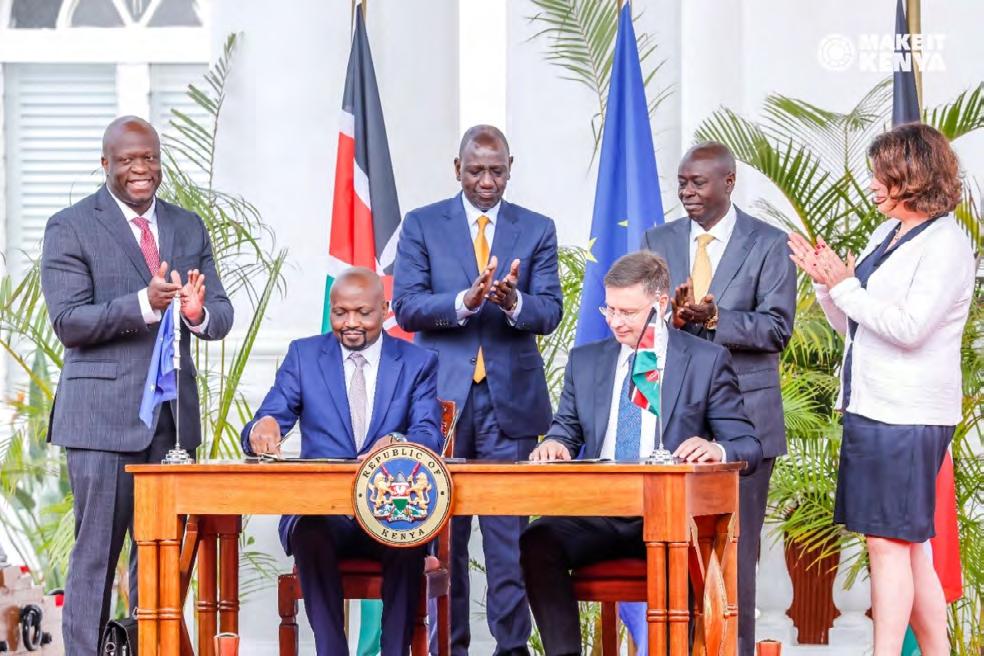
The European Union and Kenya have formally concluded the negotiations on the ambitious trade agreement that is aimed at implementing the bilateral and regional economic partnership (EPA) between the European Union and the Eastern Africa Community (EAC). The EPA was negotiated in 2014 but only Kenya and Rwanda ratified it.
The agreement is a leap forward towards KenyaEuropean Union trade in goods, development and sustainability. The EU is Kenya’s second largest trading partner and Kenya’s most important market destination. The total trade between Kenya and the EU was 3.3 billion pounds in 2022, a 27% increase from 2018. In 2022, the EU was Kenya’s top market destination with 16% of 2022’s total exports followed by Uganda at 12% and the USA at 8%.
Kenya’s exports to the European Union are 1.2 billion pounds and are mainly comprised of flowers, vegetables and fruits while Kenya’s imports from the EU amount to 2.02 billion pounds and are mainly comprised of chemical products, mineral products and machinery.
The EPA between the EU and Kenya is therefore a significant milestone and is the first agreement of a kind with an EAC nation.
What does Kenya stand to gain from the KenyaEU Economic Partnership agreement according to the European Commission.
Kenya stands to gain duty free access to the European Union market for her exports apart from firearms. On this note, the EU will also export some products to Kenya thus creating an environment for trade, investment and product diversification.
Provisions on agriculture will aim at sustainable agricultural development, including food and nutrition security, rural development, including the sustainable use and management of natural and cultural resources, and income and job creation in the agricultural sector in Kenya. These measures will guarantee that the EU will not apply export subsidies for agriculture products, even in times of market crisis.
EU development assistance, through trade capacity-building measures, will support farming and rural employment, and farmers’ capacity to comply with agricultural standards. This alignment of standards will make it easier to comply with the requirements necessary to bring those products into the EU and open trading opportunities in the agricultural sector.
The agreement includes a dedicated chapter on Trade and Sustainable Development that covers labour, gender equality, as well as environmental and climate matters. This includes the respect and promotion of the International Labour Organization fundamental rights, and the implementation of UN standards and obligations to prevent gender discrimination and support women’s empowerment.


It also commits the parties to the implementation of multilateral environmental agreements (e.g. the Paris agreement on climate change), and contains obligations to combat illegal wildlife trade, illegal logging, and illegal, unreported and unregulated fishing.
The agreement will offer the possibility of adding new areas once Kenya is ready to take up such commitments. For instance, provisions on trade in services, competition policy, investment and private sector development, intellectual property rights, transparency in public procurement could be envisaged to be added within five years following the entry into force of the deal.
Kenya is now in a great position to leverage on the EU market access to diversify her export products. The Kenya Export Promotion and Branding Agency is keen on undertaking market research in Europe to have a better understanding of product specification and embark on training and capacity building initiatives with the aim of empowering our local SMEs.
Kenya can claim a share of the 440 million consumers in the European Union. The nation is embarking on value added initiatives across the exports value chains on tea, coffee, avocado, fruits and flowers all which have ready markets in the European Union. Recently, the leading export agency through a collaboration with Open Gate Sweden recruited 10 SMEs in the three promising products namely nuts and seeds, herbs and spices, and tea and took them for a market exploration trip to Stockholm, Sweden. The SMEs were able to create business linkages and to understand customer preferences in Sweden before embarking on products exports.
By Jonah Karanja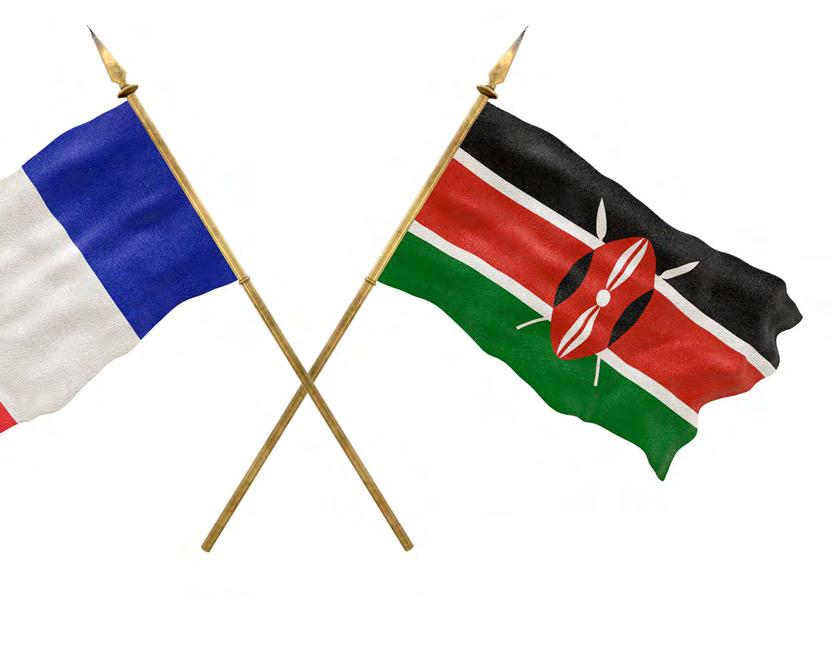
France, formerly the French Republic, is a country that is located in Western Europe and has possessions outside of the continent in the Americas, the Atlantic, Pacific, and Indian oceans. The continental area spans from the North Sea and the English Channel to the North Sea, and from the Mediterranean Sea to the Atlantic Ocean. French Guiana in South America, Saint Pierre and Miquelon in the North Atlantic, the French West Indies, and a large number of islands in Oceania and the Indian Ocean are all considered overseas territories. France has the world’s largest exclusive economic zone, with several coastline districts. Its boundaries are shared by Monaco, Italy, Andorra, Belgium, Luxembourg, Germany, Switzerland, and Spain, among other European nations. Furthermore, France maintains ties with the French Guiana and Saint Martin overseas territories.
France has the world’s largest exclusive economic zone, with several coastline districts. Its boundaries are shared by Monaco, Italy, Andorra, Belgium, Luxembourg, Germany, Switzerland, and Spain, among other European nations. Furthermore, France maintains ties to
the Netherlands, Suriname, and Brazil in the Americas through its overseas possessions of French Guiana and Saint Martin.
France comes in right behind the UK and India as the seventh-largest economic power in the world (WEF, 2022). France’s economy rebounded well in 2021 (+6.8%) following one of the worst economic contractions among EU nations in 2020 (-8%) as a result of the COVID-19 epidemic. But Russia’s invasion of Ukraine and the ensuing energy crisis hampered the recovery by lowering consumer confidence, eroding purchasing power, and making supply-side issues worse (IMF). After slowing to 2.5% in 2022, economic growth is expected to drop to 0.7% in 2023 before picking up to 1.6% in 2024, based on IMF projections.
Following a robust economic rebound from the COVID-19 epidemic in 2021, Russia’s invasion of Ukraine caused an energy crisis that negatively impacted France’s economy in 2022. France faced severe economic stagnation and rising inflation despite its reliance on nuclear energy and minimal reliance on Russian gas. To combat the crisis, a robust policy response of more than 2% of GDP was implemented, which included cash transfers to households, fuel price rebates, gas and electricity price freezes, and support for businesses (IMF).
The budget deficit dropped from 5.1% GDP in 2021 to -4.5% GDP in 2022, but because of fiscal consolidation measures (IMF), it is predicted to be high in 2023 (-4.8% GDP) before falling in 2024 (-4.3%). One of the highest levels of public debt in the Eurozone fell little from 112.6% GDP in 2021 to 111.8% GDP in 2022. It is anticipated to increase once again in 2023 (112.5% GDP) and 2024 (113.5% GDP). Inflation shot up from 2.1% in 2021 to 5.8% in 2022, driven by supply chain bottlenecks and the energy price shock, although it stayed significantly below the EU average, mainly because of energy price regulations and subsidies (IMF). According to the IMF, it was expected to peak at 4.6% in 2023 and then drop to 2.4% in 2024.
France’s President Emmanuel Macron’s visit to Kenya on March 2019 signified a great step towards the Kenya- France bilateral relations. France has been known to lean towards west African nations owing to their historical ties but the European Union’s second largest economy is slowly creating a presence in the East African region.
Kenya hosts major French firms especially in the manufacturing and energy sectors. Among the major firms in the local market are Peugeot S.A, Total Energies, NAS Servair and Donane food group which has a 40% stake at Brookside Dairies.
Other French firms in Kenya are private equity and development and finance institutions such as Amenthis Finance and Proparco have been investing in Kenyan firms such as Kenafric industries, kericho Gold Tea Processor and Equity Group. In 2020, Kenya and France signed three bilateral agreements: Construction of the Nairobi Central District to the Jomo Kenyatta International Airport railway line, 400 kV Menengai-Rongai electric line and the construction of the NairobiNakuru- Mau summit highway.
During the reviewed period, Kenya’s exports to France held steady at an average value of USD 85.2 million. However, Kenya’s imports from France surpassed its exports, averaging USD 215.1 million. Consequently, the balance of trade between the two countries tilted significantly in favor of France. Over the span of 2018 to 2022, this trade imbalance widened notably, with an average increase of USD 129.9 million per year. By 2022, the total trade between the two nations amounted to USD 269.7 million.


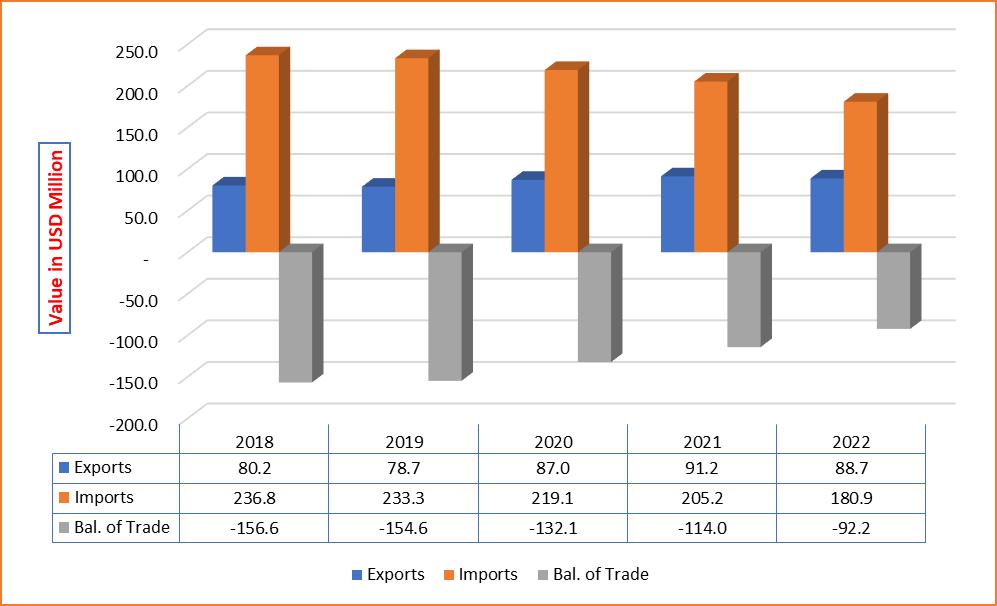
Source: International Trade Centre database 2023; Compiled by KEPROBA
In 2022, Kenya’s exports to France were valued at USD 88.7 million. The primary export products driving this trade included dates, figs, mangoes, pineapples, and other vegetables prepared with vinegar, constituting 22.3%, 21.1%, and 16.6%, respectively. Additionally, cut flowers and buds accounted for 10.1% of exports, while other fresh or chilled vegetables represented 3.8%. Collectively, these top five products comprised 76.0% of Kenya’s exports to France. This concentration underscores the importance of diversifying export products to the French market, reducing reliance on a few key items and ensuring a more resilient trade relationship.
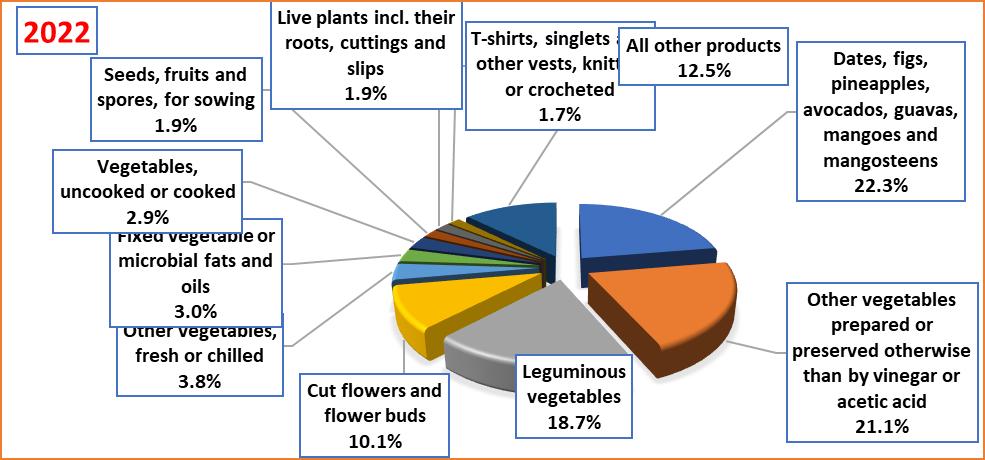
Source: International Trade Centre database 2023; Compiled by KEPROBA
In 2022, the total value of Kenya’s imports from France amounted to USD 180.9 million. This figure represented a decrease of USD 24.3 million compared to the previous year, when imports stood at USD 205.2 million. Notably, one of Kenya’s primary import categories from France in 2022 was medicaments, valued at USD 18.7 million. This highlights the importance of pharmaceutical imports in Kenya’s trade relationship with France.
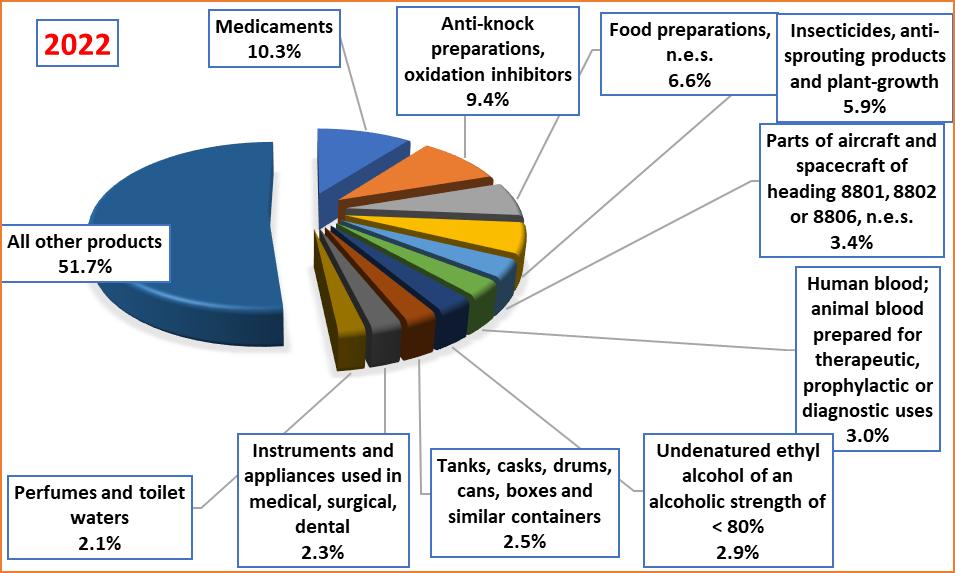
Source: International Trade Centre database 2023; Compiled by KEPROBA
Kenya’s export potential to France
Kenya possesses significant export potential to France across several product categories. Avocados, whether fresh or dried, along with coffee that is neither roasted nor decaffeinated, and unshelled beans are among the products with the highest export prospects. Additionally, Kenya boasts substantial supply capacity in black tea packaged in sizes exceeding 3kg, making it a prime candidate for export to the French market. On the flip side, medicaments for retail sale emerge as the product with the strongest demand potential in France, indicating a lucrative opportunity for Kenya to meet this market need.


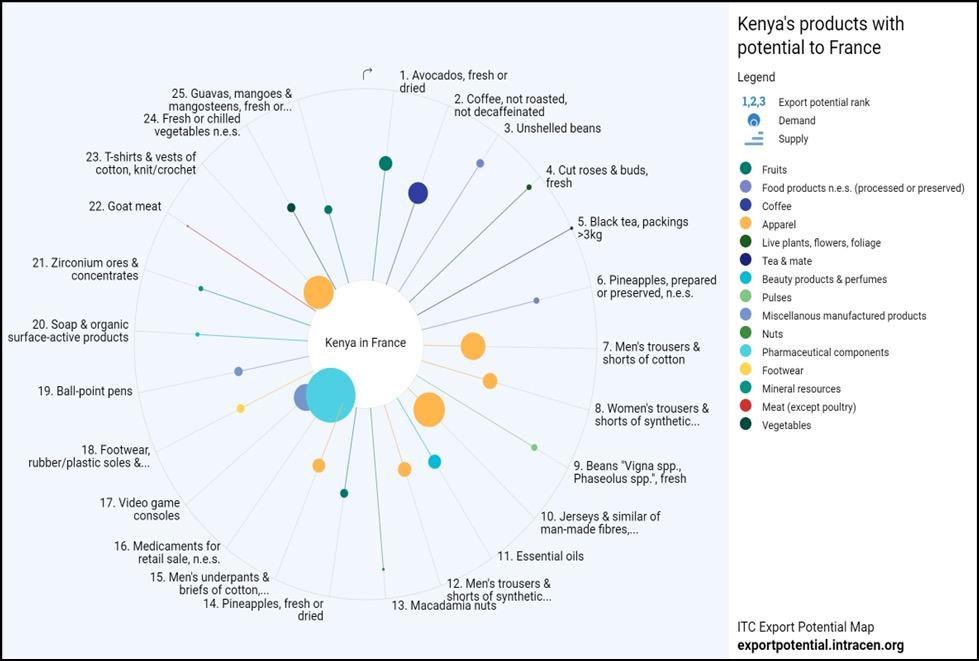
Source: International Trade Centre database 2021; Compiled by KEPROBA
By Jonah Karanja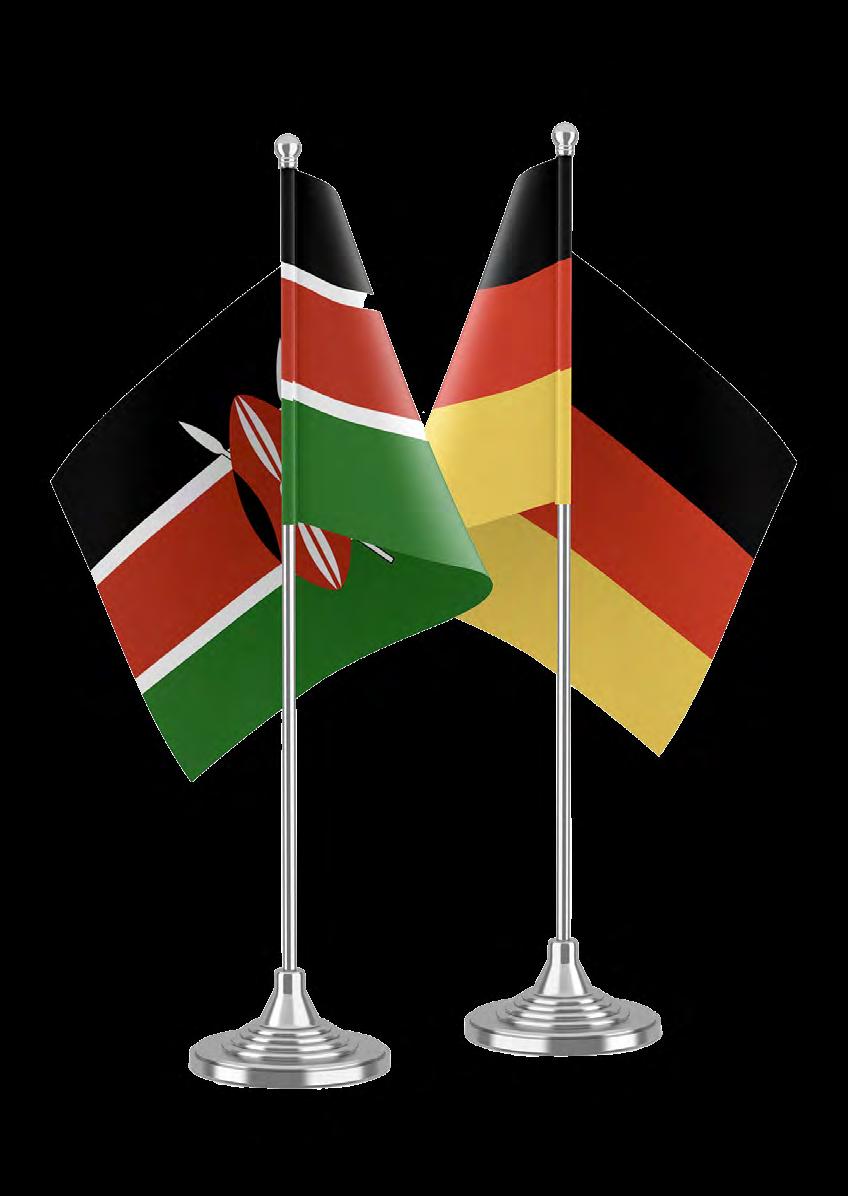
Germany, officially the Federal Republic of Germany, is a country in Central Europe. It is the second most populous country in Europe after Russia, and the most populous member state of the European Union. Germany is situated between the Baltic and North seas to the north, and the Alps to the south; it covers an area of 357,022 square kilometres (137,847 sq. mi), with a population of over 83 million within its 16 constituent states. Germany borders Denmark to the north, Poland and the Czech Republic to the east, Austria and Switzerland to the south, and France, Luxembourg, Belgium, and the Netherlands to the west. The nation’s capital and largest city is Berlin, and its financial centre is Frankfurt; the largest urban area is the Ruhr.
Germany is the top economic power in Europe and the fourth globally. After experiencing a historic recession following the COVID-19 pandemic, the country’s economy grew throughout the first three quarters of 2022 driven by an ongoing recovery in private consumption. However, Germany only grew an estimated 1.5% in 2022, slower than one year earlier (2.6% - IMF) due to the consequences of the Russia-Ukraine conflict: prior to the invasion, Germany was highly dependent on Russian gas, oil and coal, with around one-third of primary energy supply coming from Russia. The political situation and the resulting EU sanctions against Russia forced Germany to reduce such dependency; however, there were severe disruptions in the supply chain (especially in the chemicals and automotive sectors, which together account for almost 6.5% of GDP) and in energy imports. Sentiment indicators have deteriorated markedly towards the end of 2022, with a decrease in private consumption due to high inflation and rising energy costs. The IMF expects GDP to decrease by 0.3% in 2023 (-0.6% according to the EU Commission), before rebounding by 1.5% in 2024. Downside risks to the forecast remain, especially those related to delays in the energy supplies diversification, which may cause shortages and spur inflation in the winter of 2023-24.
Kenya and Germany have a diverse range of commercial interactions including multiple industries and endeavors. Kenya is a major economic force in East Africa and Germany is one of the biggest economies in Europe. The two nations participate in bilateral trade, investment, and cooperation projects. Kenya is one of the
world’s leading producers of fresh vegetables, flowers, tea, coffee, and other agricultural products. Its exports to Germany include a wide variety of goods. Additionally, processed foods, clothing, and textiles are supplied to the German market by Kenya’s rapidly expanding industrial industry.
Conversely, Germany exports a vast range of goods and services, including machinery, chemicals, automotive components, technology, and engineering know-how, to Kenya. German businesses frequently make investments in Kenya in a range of industries, such as manufacturing, infrastructure development, and renewable energy, helping the country’s economy flourish and create jobs. Beyond the exchange of commodities and services, Kenya and Germany work together on several development initiatives that support Kenya’s capacity-building and sustainable development. Initiatives in the fields of infrastructure, healthcare, education, and agriculture are included in this, with backing from German non-governmental organizations, development agencies, and business players.
Through educational exchanges, vocational training programs, and research partnerships, Germany also plays a significant role in providing Kenya with technical support, information transfer, and skills development. These partnerships strengthen Kenya’s institutional capacity in several sectors and aid in the development of human capital.
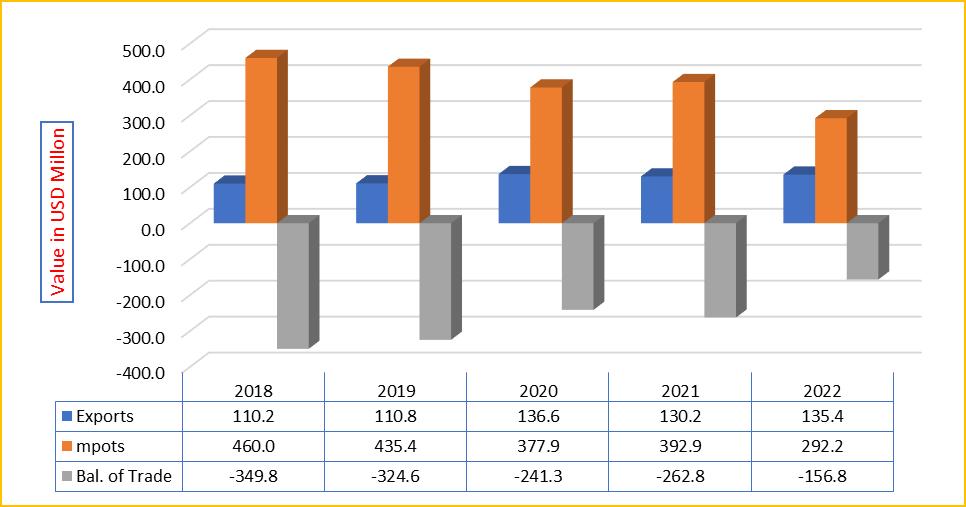
Source: International Trade Centre database 2023; Compiled by KEPROBA


In the assessed period, Kenya’s exports to Germany maintained an average value of USD 120.3 million, indicating a consistent flow of goods from Kenya to the German market. Conversely, imports from Germany into Kenya exceeded exports, averaging USD 416.2 million, highlighting Germany’s significance as a source of imported goods for Kenya.
Kenya’s export performance demonstrated steady growth, with a 5.8% increase observed between 2018 and 2022, and a 4.0% growth specifically between 2021 and 2022. However, imports from Germany exhibited a contrasting
trend, declining at an average rate of 10.1% from 2018 to 2022, with a sharper decrease of 25.6% noted between 2021 and 2022.
The widening trade imbalance between the two nations favoured Germany, as evidenced by an average value of USD 296.0 million between 2018 and 2022. In 2022, the total trade between Kenya and Germany amounted to USD 522.3 million, underscoring the significant trade relationship between the two countries despite the trade disparity.
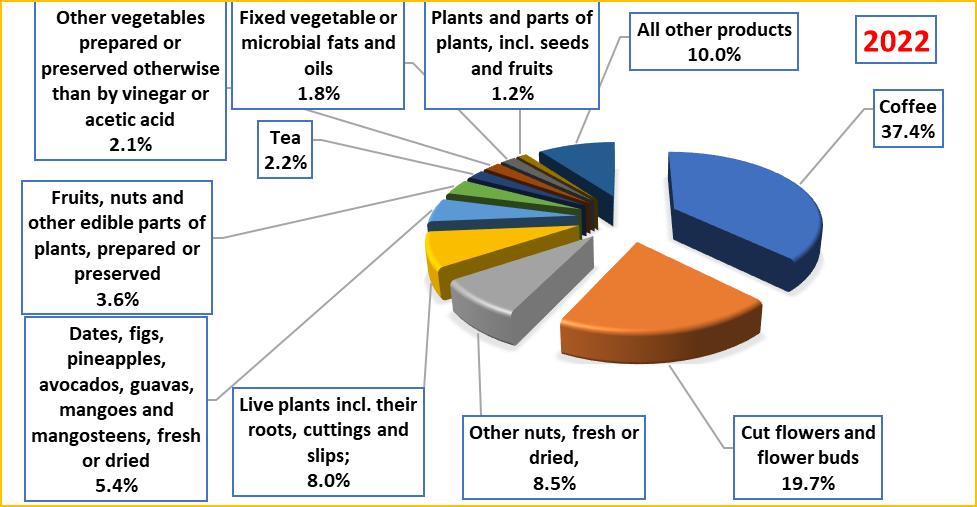
Source: International Trade Centre database 2023; Compiled by KEPROBA
there is need for product diversification in this market.
Source: International Trade Centre database 2022; Compiled by KEPROBA.
Kenya exports to Germany was valued at USD 130.1 million in 2021. Her leading export products include Cut flower and flower buds 27.4%, Coffee 21.4% and Live plants 10.5%.
Top five products accounted for 75.3% therefore
In 2022, Kenya’s imports from Germany were valued at USD 292.1 million, reflecting a significant portion of the country’s import activity originating from German sources. This marked a notable decrease from the previous year, with imports falling by USD 100.7 million from USD 392.9 million in 2021 to USD 292.2 million in 2022.
Among the key import products from Germany in 2022, medicaments stood out as the leading category, constituting 16.5% of Kenya’s total imports from Germany. This underscores the importance of pharmaceuticals and medical supplies in Kenya’s import portfolio from
Germany, reflecting the vital role these products play in supporting healthcare and wellness initiatives within the country.
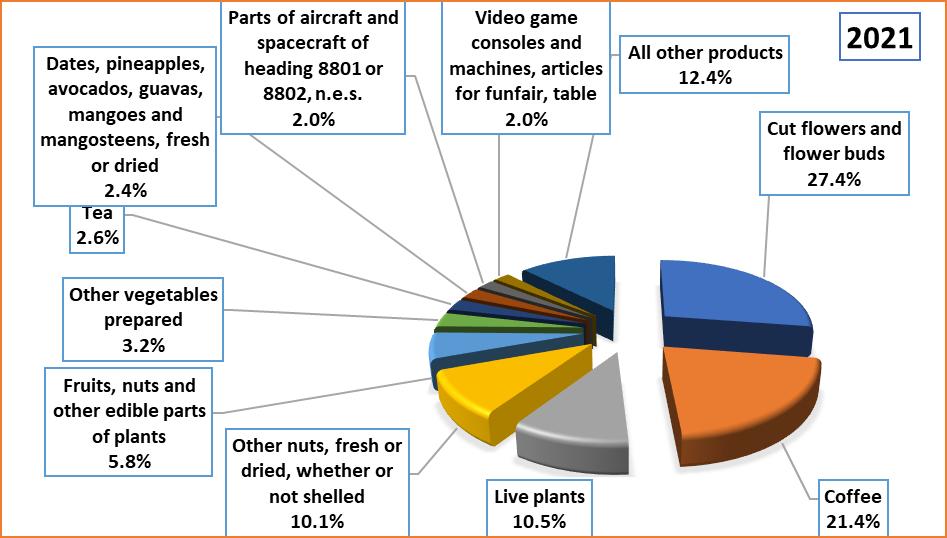
Source: International Trade Centre database 2023; Compiled by KEPROBA
Kenya boasts significant export potential to Germany across various product categories. Notably, black tea in packings exceeding 3 kilograms, coffee in its unroasted and nondecaffeinated form, and fresh or dried avocados emerge as products with promising export opportunities.
Of these, Kenya demonstrates the highest supply capacity in black tea, particularly in packings exceeding 3 kilograms. This underscores Kenya’s strength in the tea industry and its ability to meet the demand for larger packaging formats in the German market.
Meanwhile, medicaments, comprising mixed or unmixed products intended for retail sale, represent a product category with strong demand potential in Germany. This suggests a lucrative market opportunity for pharmaceuticals and healthcare-related products sourced from Kenya, highlighting the importance of meeting quality standards and regulatory requirements to capitalize on this demand.
By leveraging its strengths in these key export products and understanding the demand dynamics in Germany, Kenya can further enhance its export presence and economic engagement with one of its significant trading partners.



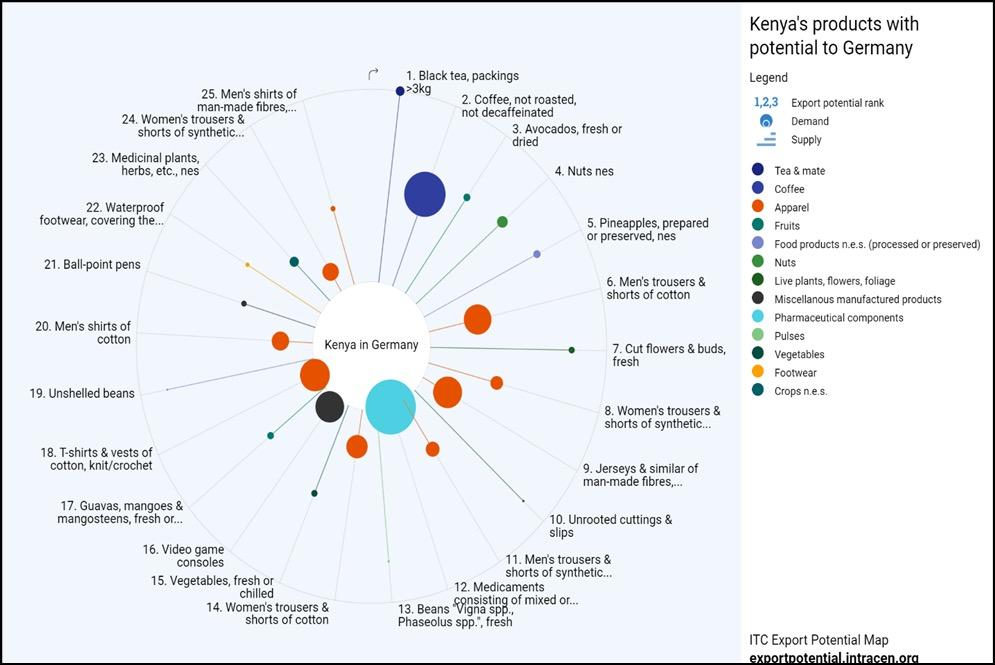
Source: International Trade Centre database 2023; Compiled by KEPROBA
Challenges and recommendations in exporting to Germany
One of the core problems of setting up a business in Germany be it local or foreign in the rigorous process of applications that one has to follow. Germany is ranked 106th in the ease of doing business due to the lengthy processes that stem from liaising with local chamber of commerce, local standard industries and various professional bodies relevant to the nature of business.
Germany requires a cross-cultural awareness for interests in its economy, a stern compliance with the export import requirements which takes weeks to clear. However, the process of clearance is affordable. The capability of the government to protect investors and to uphold
standards and procedures in the business sector creates a timely experience for businessperson.
It is hard for countries that pose less innovative products that do not provide high quality and style to the German market to gain entry.
A compound recommendation to these hurdles would be intense market intelligence. The market analysis on culture, business behaviour, opportunity and level of quality, standards and innovation can allow foreigners develop market strategies that allow cooperation and better access into the economy.
By Jonah Karanja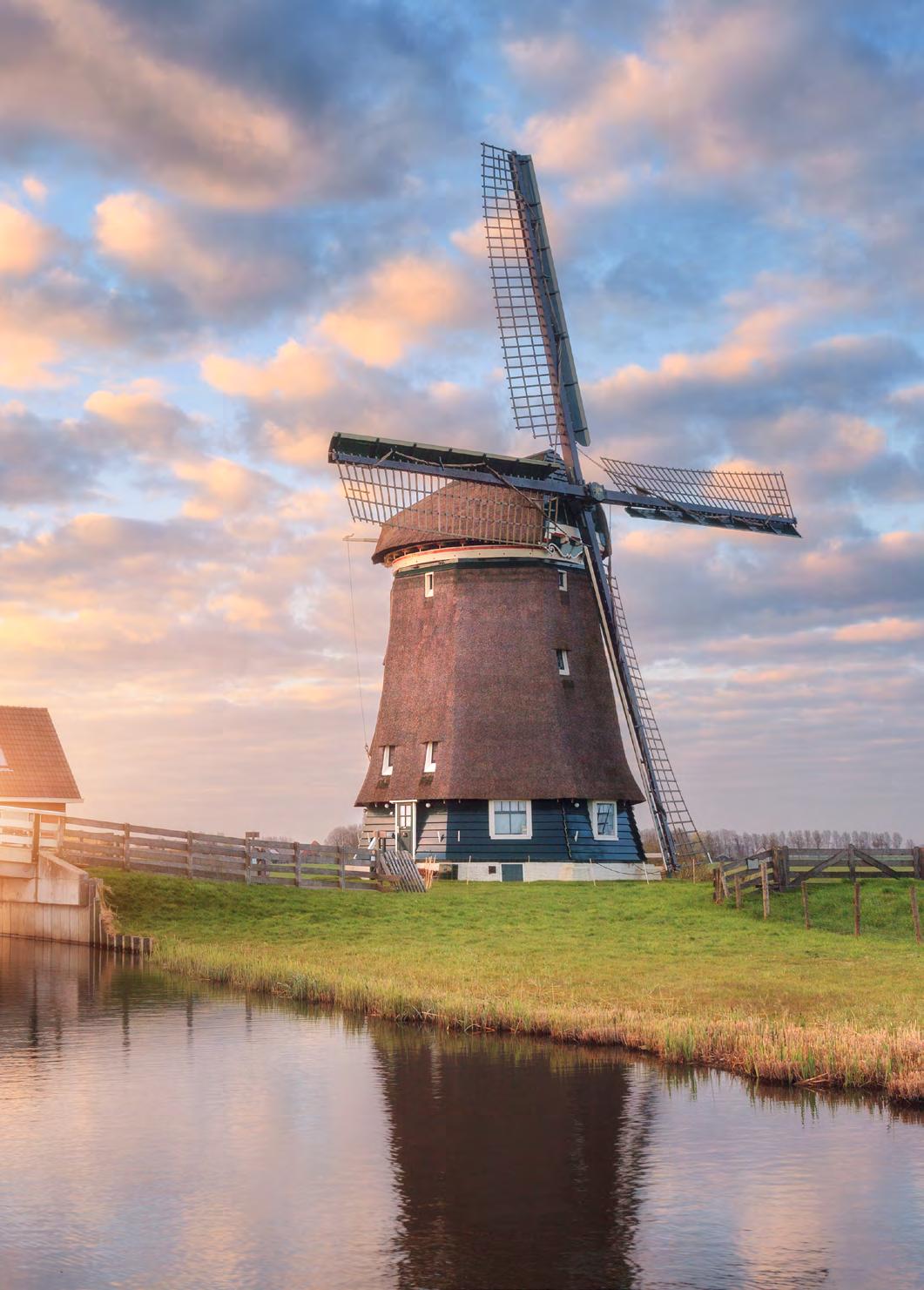
The Netherlands is located next to Germany and Belgium to the East of its boarders and to the South respectively. To the Northwest is the North Sea. The country shares its maritime boarders with its two neighbouring countries as well as the United Kingdom. The country is broken into 12 provinces with the largest cities being Amsterdam, Rotterdam, The Hague and Utrecht. The Netherlands has special municipalities in the Caribbean i.e; the islands of Bonaire, Sint Eustatius and Saba. The country covers 41,865 km2 with an average population estimated to be 17.616 million. The
capital city is Amsterdam, which doubles up as the largest city in the country. The official language is Dutch with English, Papiamento and West Frisian being co-official languages. Other used and recognized languages include Dutch Low Saxon, Dutch Sign Language, Limburgish, Sinte Romani and Yiddish.
Mutual economic gains characterize the dynamic commercial relationship between Kenya and the Netherlands. Kenya’s strategic location in East Africa and the Netherlands’ status as a major European commerce hub allow the two nations to engage in a wide range of trade activities.
Kenya is a major producer of fresh produce, flowers, tea, coffee, and other agricultural items, which are among its exports to the Netherlands. Furthermore, Kenya’s rapidly expanding manufacturing sector supplies the Dutch market with products including clothing, textiles, and processed foods.
Conversely, Kenya receives a large volume of exports from the Netherlands, including technology, machinery, equipment, and chemicals. The Netherlands’ proficiency in fields such as horticulture, water management, and renewable energy offers prospects for cooperation and funding in Kenya’s development projects. Beyond products and services, collaborations in research, education, and technology transfer are also part of Kenya and the Netherlands’ trading relationship.
By promoting innovation and knowledge sharing, this partnership advances sustainable development in both nations. Furthermore, the Netherlands’ well-established logistics and distribution networks make it a crucial entry point for Kenyan goods looking to enter the larger European market.


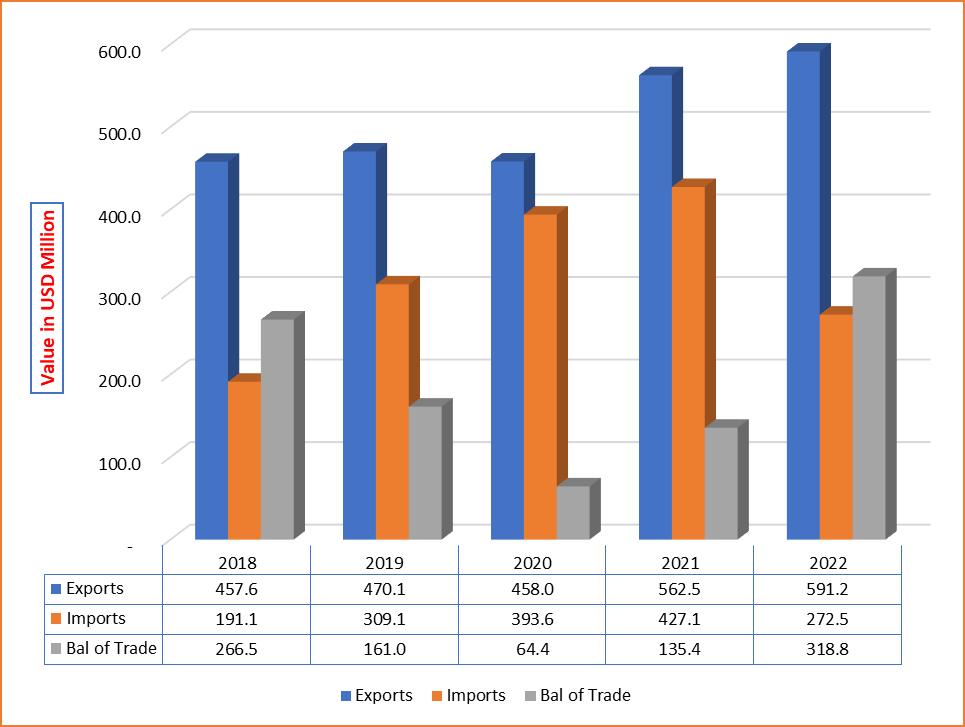
Source: International Trade Centre database 2022; Compiled by KEPROBA
Over the past five years, Kenya’s exports to the Netherlands have shown a consistent upward trend, rising from USD 458 million in 2018 to USD 591.2 million in 2022. Meanwhile, Kenya’s imports from the Netherlands have also been on the rise during this period. Starting at USD 191 million in 2018, they surged to USD 427 million in 2021, although there was a slight drop to USD 272.5 million in 2022.
Throughout the period from 2018 to 2022, Kenya’s exports to the Netherlands averaged USD 507.9 million, while imports from the Netherlands averaged USD 318.7 million. Despite fluctuations in import figures, the balance of trade consistently favored Kenya during this period.
These trends underscore the strengthening economic ties between Kenya and the Netherlands, with Kenya demonstrating steady growth in its exports to the Netherlands and maintaining a favorable trade balance over the five-year period.
In 2022, Kenya’s primary export commodity to the Netherlands was cut flowers and flower buds, making up a significant 45.3% of Kenya’s total exports to the country. Other notable export items included non-crude petroleum oils and oils, accounting for 25.5%, followed by a variety of fruits such as dates, figs, pineapples, avocados, guavas, mangoes, and mangosteens,
representing 6.3% of total exports. Live plants comprised 5.4% of exports, while plants and parts of plants, including seeds, made up 3.5%.
The combined value of these top five export products accounted for 85.6% of Kenya’s total exports to the Netherlands, indicating a high level of concentration in the export portfolio. This emphasizes the importance of these key products in driving Kenya’s export trade with the Netherlands.
Kenya possesses significant export potential to the Netherlands in several key product categories. Cut flowers and buds, along with fresh avocados
and unrooted cuttings and slips, stand out as products with considerable export opportunities. Moreover, Kenya boasts the highest supply capacity in black tea, particularly in packings exceeding 3 kilograms.
Among the products facing strong demand potential in the Netherlands, crude palm oil emerges as particularly noteworthy. This suggests a promising avenue for Kenya to tap into the Dutch market and capitalize on the robust demand for this commodity. By leveraging its strengths in these product categories and understanding the demand dynamics in the Netherlands, Kenya can further enhance its export presence and economic engagement with the country.
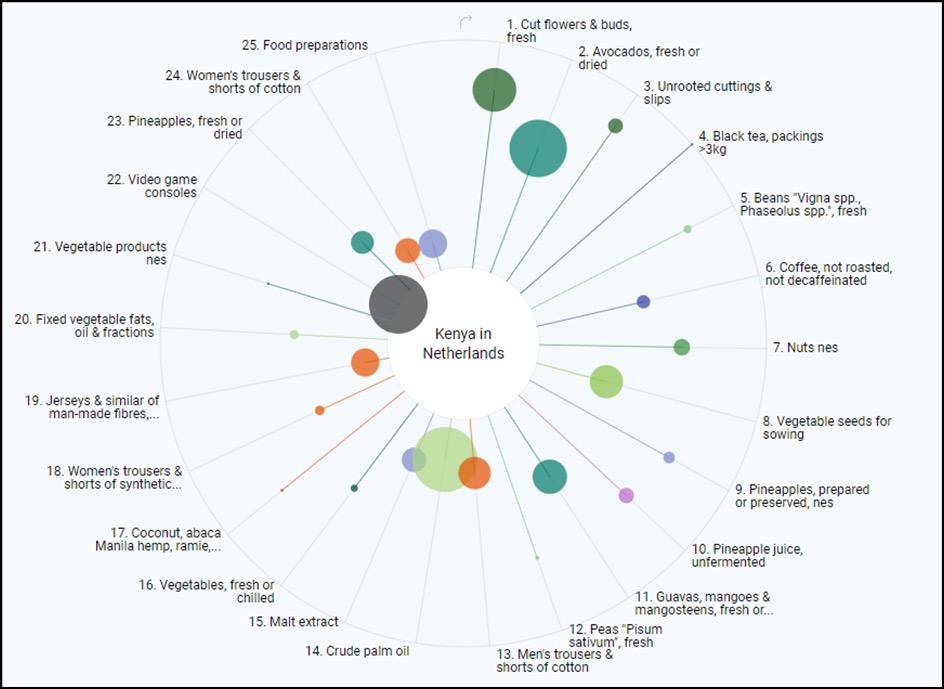
Source: International Trade Centre database 2022; Compiled by KEPROBA
Partnerships
The enduring diplomatic ties between Kenya and the Netherlands have paved the way for numerous collaborative development initiatives. Notably, both nations have focused their efforts


on bolstering Kenya’s healthcare sector. Amid the peak of the Covid-19 pandemic in 2021, the Dutch government generously contributed by donating 750,700 doses of the AstraZeneca Covid-19 vaccine. Additionally, the Netherlands has provided crucial support for infrastructural enhancements in more than 23 hospitals across Kenya.
The ongoing cooperation between the Netherlands and Kenya in the healthcare domain serves as a testament to the strong bond shared between the two nations. The Netherlands has assumed a pivotal role in combating childhood cancer and improving healthcare access for
vulnerable communities in Kenya. Furthermore, the Netherlands is actively involved in promoting the local manufacturing of essential health products within Kenya, thereby contributing to the nation’s self-sufficiency in healthcare provisions. This collaborative effort underscores the depth of the relationship between Kenya and the Netherlands and their shared commitment to fostering development and well-being within Kenya.
By Jonah Karanja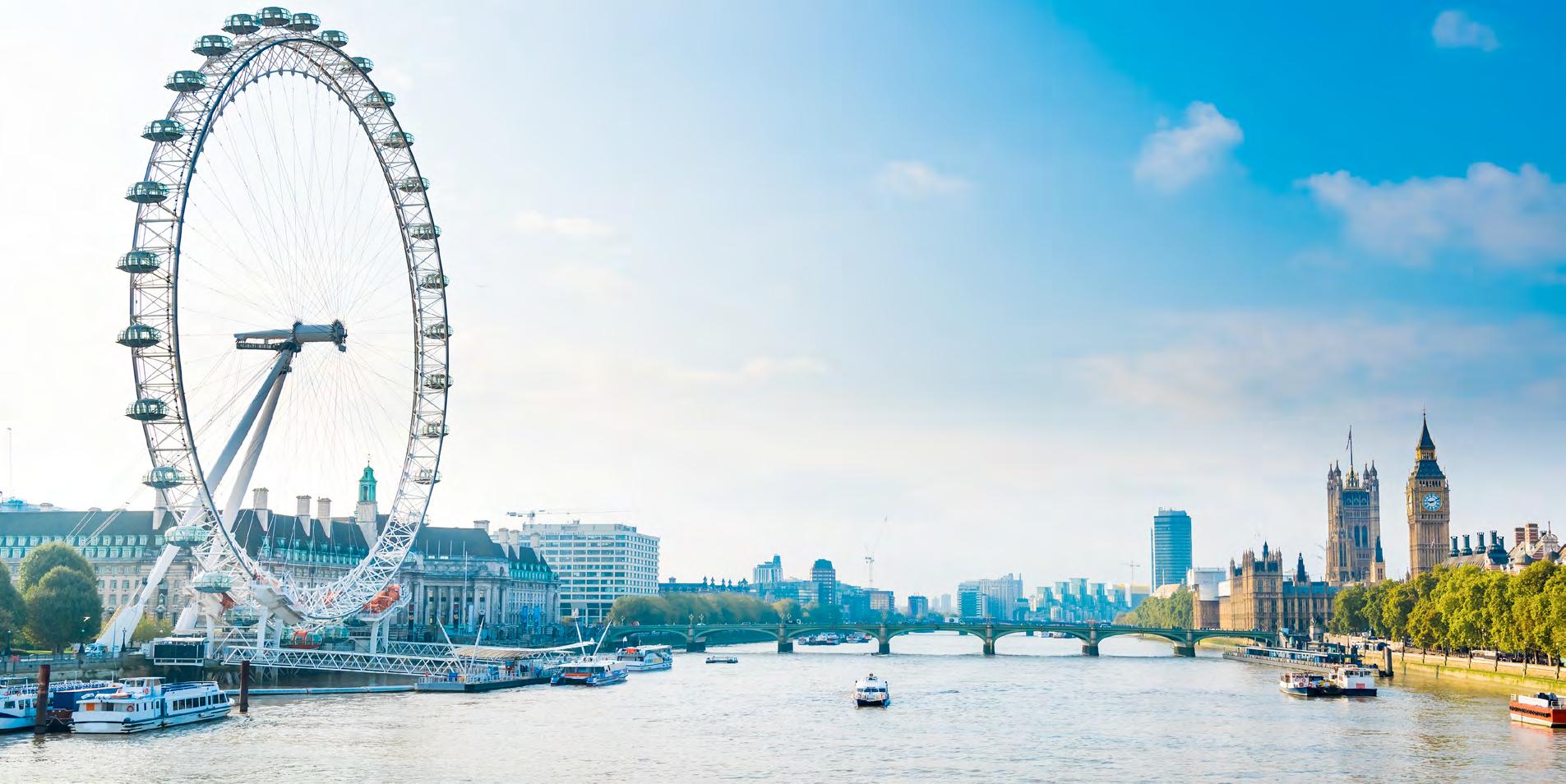
The United Kingdom of Great Britain and Northern Ireland, commonly known as the United Kingdom (UK) or Britain, is a sovereign country in Europe. It comprises England, Wales, Scotland, and Northern Ireland. The United Kingdom includes the island of Great Britain, the northeastern part of the island of Ireland, and many smaller islands within the British Isles. Northern Ireland shares a land border with the Republic of Ireland; otherwise, the United Kingdom is surrounded by the Atlantic Ocean, the North
Sea, the English Channel, the Celtic Sea and the Irish Sea. The total area of the United Kingdom is 242,495 square kilometres with an estimated population of more than 67 million people.
The United Kingdom stands as the world’s sixth-largest economy, but its recent economic trajectory has been marked by significant challenges. In 2020, the UK experienced a severe contraction of -9.3% in GDP, primarily attributed to the disruptions caused by the COVID-19 pandemic. However, the economy rebounded strongly in 2021, with GDP growth reaching 7.4%.
Yet, this momentum slowed down considerably in 2022, registering a growth rate of 3.6%, influenced by persistent supply shortages and escalating inflation, as noted by the International Monetary Fund (IMF).
Looking ahead, both the IMF and the Organisation for Economic Co-operation and Development (OECD) foresee further economic deceleration for the UK. The IMF projected the GDP growth to decrease sharply to 0.3% in 2023 and 0.6% in 2024. The OECD’s outlook was even more pessimistic, anticipating an economic contraction of 0.4% in 2023, followed by a modest recovery with a growth rate of 0.2% in 2024.
Several factors contribute to these subdued growth prospects. Beyond the lingering impacts of Brexit-related trade disruptions, the UK grapples with ongoing supply-side constraints and acute labor shortages, aggravated by the conflict in Ukraine. These challenges hinder the country’s ability to ramp up production and meet demand, exerting downward pressure on economic performance. Moreover, business investment remains muted due to elevated capital costs and prevailing uncertainty surrounding economic conditions, as highlighted by the OECD.
Kenya was ruled by the British during colonial periods, which is when the history of trade between Kenya and the UK began. Kenya has established and maintained a strong trading connection with the UK since achieving independence in 1963, albeit this relationship has changed significantly over time.
Kenya’s primary role in the colonial era was to supply the UK with agricultural products and raw materials; in return, the UK gave Kenya manufactured goods and technological developments. Kenya continued to trade with the UK after independence, sending a wide range of goods to the UK, including tea, coffee, flowers, fruits, and vegetables. Kenyan exports continued to find a significant market in the UK, especially in the agriculture sector.
In the reviewed period, Kenya’s exports to the United Kingdom maintained an average value of USD 417.4 million. However, Kenya’s imports from the UK surpassed its exports, averaging USD 303.4 million. Consequently, the balance of trade between the two countries shifted notably in favor of Kenya. Over the span of 2018 to 2022, this trade imbalance widened, with an average increase of USD 114.0 million per year. By 2022, the total trade between Kenya and the UK amounted to USD 673.5 million.
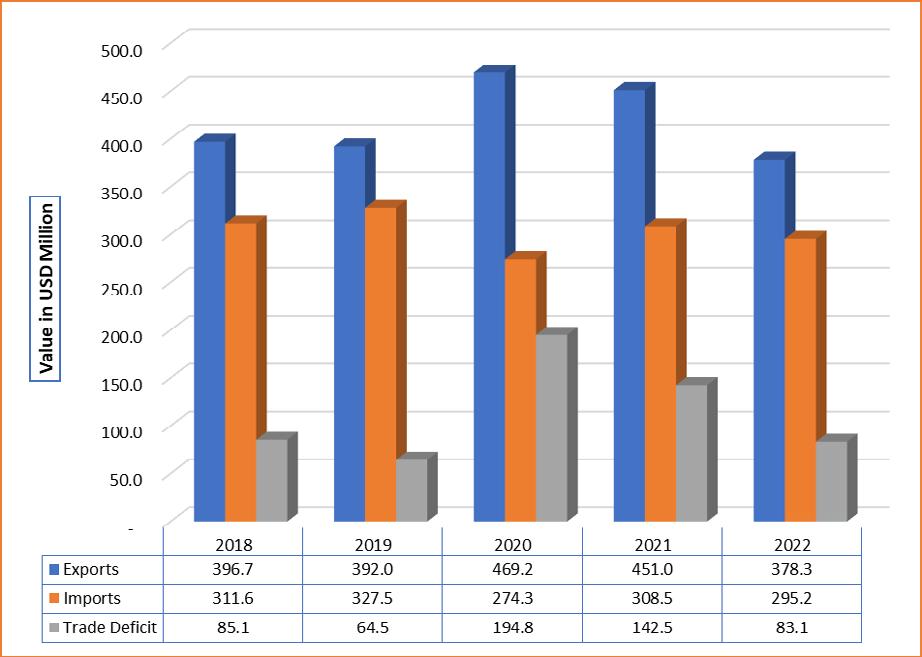
Source: International Trade Centre database 2023; Compiled by KEPROBA
In 2022, Kenya’s exports to the UK were valued at USD 378.3 million, reflecting a negative average growth rate of -0.4% between 2018 and 2022, and a sharper decline of -16.4% between 2021 and 2022. Despite these challenges, Kenya’s leading export products to the UK remained robust, with cut flowers and flower buds constituting 28.9% of exports, followed closely by tea at 28.1%, and other fresh or dried vegetables at 9.8%. Together, these top five products accounted for 78.2% of Kenya’s total exports to the UK. However, this high concentration emphasizes the need for Kenya to diversify its export product portfolio in the UK market, reducing reliance on a few key items and enhancing resilience to market fluctuations.
In 2022, Kenya’s imports from the UK were valued at USD 295.2 million, indicating a decrease of USD 13.3 million from the previous year’s total of USD 308.5 million. Notably, one of Kenya’s primary


import categories from the UK in 2022 was petroleum oil and oils ex-crude, valued at USD 31.5 million. This underscores the significance of petroleum imports from the UK for Kenya’s market.
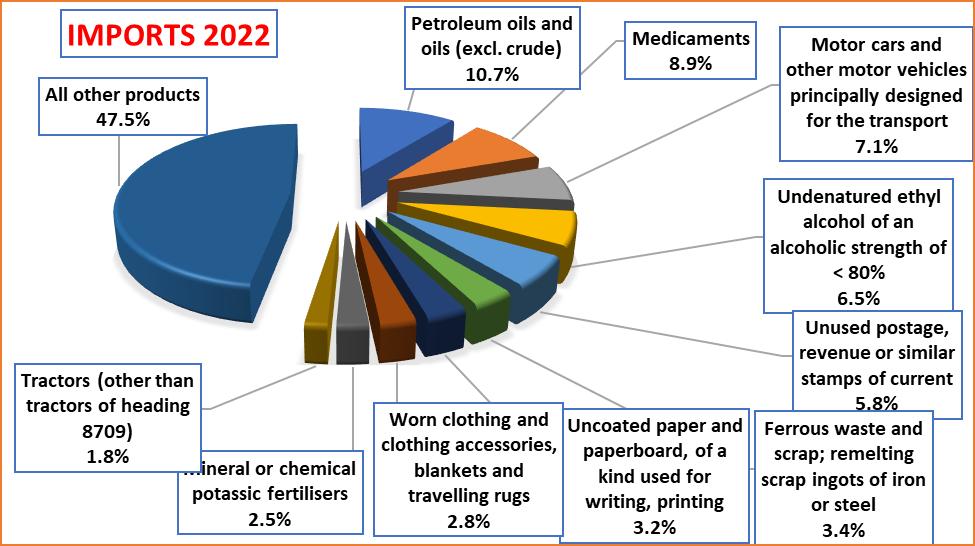
Source: International Trade Centre database 2021; Compiled by KEPROBA
Kenya’s Potential Exports to UK
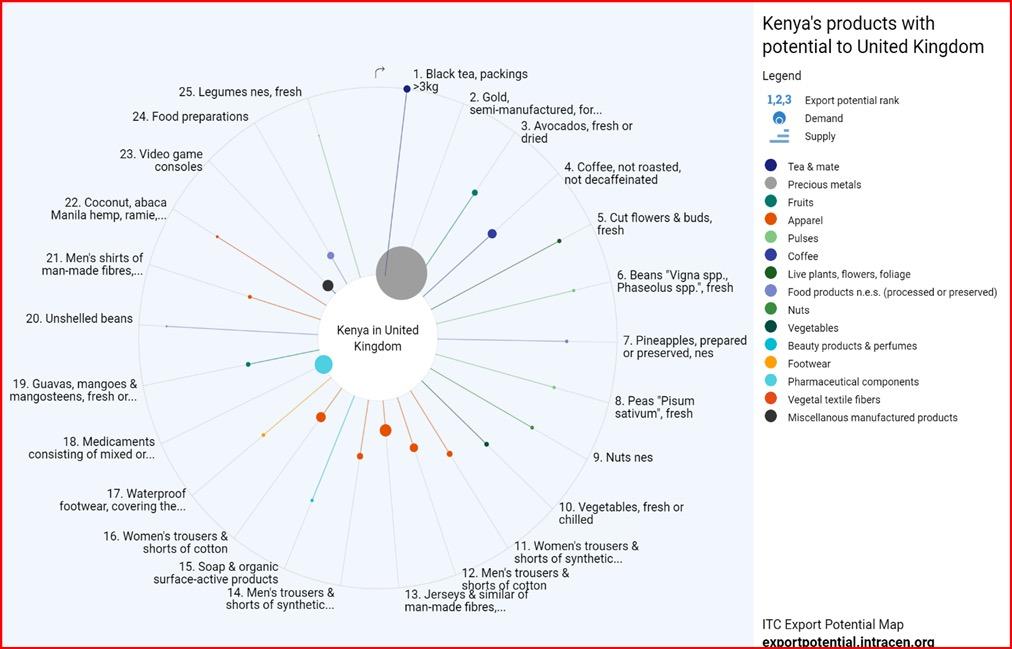
Source: International Trade Centre database 2023; Compiled by KEPROBA
Kenya boasts significant export potential to the United Kingdom across several product categories. Black tea packaged in sizes exceeding 3kg, gold semi-manufactured for non-monetary purposes, and avocados, whether fresh or dried, emerge as the products with the greatest promise for export to the UK market. Among these, Kenya exhibits the highest supply capacity in black tea
packaged in sizes exceeding 3kg. Meanwhile, gold semi-manufactured for non-monetary purposes stands out as the product facing the strongest demand potential in the United Kingdom, indicating a lucrative opportunity for Kenya to meet this market need.
By Jonah KaranjaKenya Export Promotion and Branding Agency
1st & 16th Floors, Anniversary Towers, University Way
P. O. Box 40247 – 00100 GPO Nairobi Kenya.
Tel. + 254 20 222 85 34-8
Cellphone: +254722 205 875 | +254734 228 534
Email: info@brandke.ke Web: www.KEPROBA
Kenya Investment Authority
UAP Old Mutual Towers, Upper Hill 14th and 15th Flr
P.O. Box 55704-00200, Nairobi Tel: (+254) 730104200
Email: info@invest.go.ke www.invest.go.ke
The National Treasury
Treasury Building, Harambee Avenue P.O. Box 30007-00100, Nairobi
Tel. +254 20 2252299
Email: ps@treasury.go.ke
Website: www.treasury.go.ke
Vision 2030 Delivery
Secretariat KUSSCO Centre, 2nd Flr, Upper Hill. P.O. Box 52301 - 00200, Nairobi Tel: +254-20-272 20 30, +254-20-272 22 004
Email: info@vision2030.go.ke
Website: www.vision2030.go.ke
Ministry of Foreign Affairs
Old Treasury Building, Harambee Avenue P.O Box 30551 – 00100 G.P.O NAIROBI, Kenya
Tel: +254 20 3318888 Email: info@mfa.go.ke Website: www.mfa.go.ke
Ministry of Industry, Trade & Entreprise
Development
Social Security House, Block A, 17th, 23rd Flr P.O. Box 30418-00100, Nairobi, Kenya
Tel: +254 20-2731531
Email: ps@industrialization.go.ke
Website: www.industrialization.go.ke
Agriculture and Food Authority
Head of Coffee Directorate
Coffee Plaza, 10th Floor Haile Selassie Avenue P.O Box 30566 – 00100 Nairobi
Telephone: +254 710 670 026, +254 788 494 579, +254 20 334 2717
Email: coffeedirectorate@gmail.com, directorcoffee@agricultureauthority.go.ke
Website: coffee.agricultureauthority.go.ke
Presidential Delivery Unit
Physical Address: 24th Floor Kenyatta International Conference Centre
P.O. Box 40530-00100
Tel: +254-20-2217774/3
Email: pdu@president.go.ke
Website: www.delivery,go.ke
LAPSSET Corridor Development Authority
Chester House Building. P.O. Box 45008 - 00100, Koinange Street, Nairobi
Tel: +254-(0)20-2218968
Website: www.lapsset.go.ke
Ministry of Petroleum and Mining, P.O. Box 30009 – 00100, Phone: +254 (020) 2723101
Email: cs@petroleumandmining.go.ke Website: www.petroleumandmining.go.ke
Ministry of Energy
Nyayo House, 23rd floor, Kenyatta Avenue P.O. Box 30582 - 00100, Nairobi Tel: (+254) 020 310112
Cell: 0726 993 292, Email: info@energy.go.ke Website: www.energy.go.ke
Kenya Plant Health Inspectorate Service KEPHIS
Physical Address:
P.O. Box 49592-00100, Nairobi Tel: 020 661 8000
Email : kephisinfo@kephis.org
Website: www. Kephis.org


Physical Address: First Floor Embankment Plaza
Longonot Rd, Upperhill Hill,Nairobi P.O. Box 3694300200, Nairobi
Tel: +254 (20) 4965000
Email: contactcentre@kentrade.go.ke
Website: www.kentrade.go.ke .
Kenya Tourism Board
Head OfficeKenya-Re Towers, Ragati Road P.O. BOX 30630 – 00100 Nairobi,Kenya
Telephone: +254 20 2711 262Pilot No: +254 20 2749 000
Fax: +254 20 271 9925
Email: info@ktb.go.ke
Kenya Revenue Authourity
Physical Address: Times Tower Building, Haile Selassie Avenue
P.O. Box 48240 - 00100
Tel: +254 20 281 0000
Email: callcentre@kra.go.ke
Website: www.kra.go.ke
Immigration Department
Nyayo House 20th floor, Kenyatta Avenue/Uhuru Highway
P.O Box 30395 – 00100 Nairobi. Tel: +254-202222022
Email; dis@immigration.go.ke Website www.immigration.go.ke
Kenya Private Sector Alliance
5th Floor, Shelter Afrique Building, Mamlaka Rd. P.O. Box 3556-00100 Nairobi, Kenya
Phone +254 202730371|2|2727936|883 +254 720 340949|735 999979
Email: info@kepsa.or.ke
Kenya Association of Manufacturers 15 Mwanzi Road opp West Gate Mall, Westlands, Nairobi, Kenya
Email: info@kam.co.ke
Mobile: +254 (0) 722201368, 734646004/5
Telephone: +254 (020) 232481
Kenya National Chamber of Commerce and Industry
Heritan House, Off Argwings Kodhek
Phone: +254 20 3927000
Email: info@kenyachamber.or.ke
Fresh Produce Exporters Association of Kenya
New Rehema House, 4th Floor Westlands, Nairobi, Kenya P.O. Box 40312-00100, Nairobi
Telephone: +254 020 516 0333
Email: info@fpeak.org
Kenya Flower Council Suite 12, 4th Floor, The Greenhouse Building, Adams Arcade, along Ngong Road
Tel. No: +254 20 2439523
Mobile: +254 733 639 523
Email: info@kenyaflowercouncil.org
Konza Technopolis Development Authority (KoTDA) Westlands, Capital West Business Centre 5th Floor, Opposite New Rehema House at the intersection of Rhapta Road & Lantana Road P.O. Box 30519-00100
Nairobi, Kenya
Email: konza@konzacity.go.ke
Tel: +254(0) 204343013/4
Export Processing Zones Authority
Administration Building,Viwanda Road, off NairobiNamanga Highway, Athi River, Kenya P.O. Box 50563, Nairobi 00200, Kenya
Email: info@epzakenya.com
Safaricom: 0709 537 000/ 0713-051172/3
Airtel: 0786-683222, 0733-683222
Telkom ISDN: 045-6621000
VoIP Lines: 020-7606040/3
